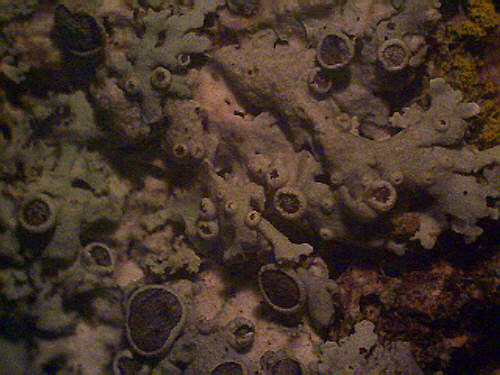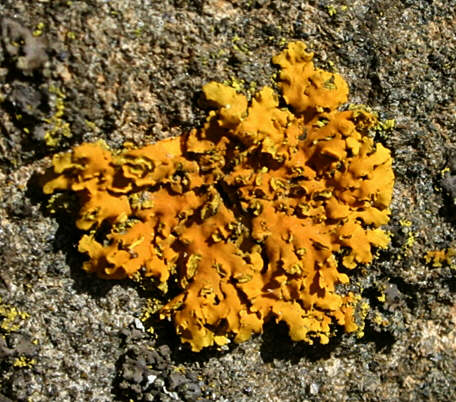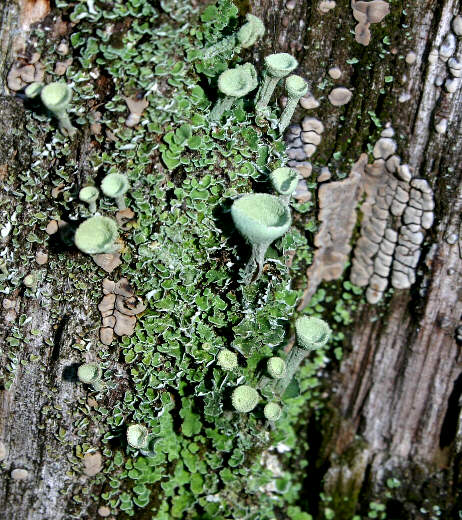LICHEN
Jack Schmidling Productions, Inc.
Marengo Illinois
MOST RECENT PHOTOS PHOTO INDEX HOME PAGE
New SLIDE SHOW New

LICHEN
Lichens are sort of dismissed as that stuff that grows on trees and to the casual observer, it all looks the same.
As a life long naturalist, I was never quite so casual about it but was surprised to lean how many species can be found just in our local area.
Last Fall, we were invited to join a " Lichen Tour" sponsored by the Chicago (you guessed it) Lichenological Society and were rather overwhelmed by the details involved in identifying them. Few of them have common names so we came home with a list of Latin names that we forgot about as fast as we learned them
One of the interesting aspects of Lichens is that they epitomize symbiosis. Most of what one sees of a lichen is called the thalus and is a fungus. Thriving within the thalus is an alga that is totally dependent upon the fungus for it's survival. It can live nowhere else. In return for comfortable living quarters, the algae produce food for the fungus via photosynthesis. The fungus can not survive with out this energy source so we have the example of a classic obligatory symbiotic relationship. This also explains why lichens can be found growing in the middle of a rock in the middle of nowhere.
In our photo, the gray spreading fans are the thali and the cups are the fruiting bodies containing the spores. In more familiar fungi, these would be the mushrooms.
For more information on the Chicago Lichenological Society,
Chi Lichens
Or contact Rich Hyerczyk at: chicagolichens@yahoo.com

LICHEN
Xanthomendoza fallax
This lichen was found on a large rock in the ditch in front of the house.
My field guide calls it Orange Tree Lichen so it took an email exchange with Rich Hyerczyk to learn
that he has found it growing on any kind of rock or tree.
So much for common names.
One of the interesting aspects of Lichens is that they epitomize symbiosis. Most of what one sees of a lichen is called the thalus and is a fungus. Thriving within the thalus is an alga that is totally dependent upon the fungus for it's survival. It can live nowhere else. In return for comfortable living quarters, the algae produce food for the fungus via photosynthesis. The fungus can not survive with out this energy source so we have the example of a classic obligatory symbiotic relationship. This also explains why lichens can be found growing in the middle of a rock in the middle of nowhere.
In our photo, the gray spreading fans are the thali and the cups are the fruiting bodies containing the spores. In more familiar fungi, these would be the mushrooms.
Or contact Rich Hyerczyk at: chicagolichens@yahoo.com

LICHEN
Xanthomendoza fallax
This lichen was found on a large rock in the ditch in front of the house.
My field guide calls it Orange Tree Lichen so it took an email exchange with Rich Hyerczyk to learn
that he has found it growing on any kind of rock or tree.
So much for common names.

PIXIE-CUP LICHEN
Cladonia chlorophaea
Although a common fruiticose lichen, this is the only group we have found around here.
The fruiting bodies grow out of the edges of the cups.
The gray cracked mass to the right and scattered throughout is also a lichen but I can not seem to find it in my references.
I trust someone from the Chicago Lichenological Society will help me out here.
Here with comments from Rich Hyerczyk, Chicago Lichens
"This particular lichen (the Cladonia chlorophaea
complex) has at least 3 to 4 species that look
identical morphologically, but chemically they differ.
All have cups. This group is identified, species-wise,
base on the acids they contain, not really on cups
size or anything like that. Lichen acids are best
detected using thin-layer chromatography.
Cladonia grayi has grayanic acid
Cladonia chlorophaea has fumarprotocetraric acid
Cladonia cryptochlorophaea has cryptochlorophaeic acid
And so on…
So, I really don’t know what species you show, only
that it is a Cladonia. I guess calling it Cladonia
chlorophaea (pixie-cup lichen) is fine too.
2. The gray cracked mass growing with the Cladonia is
a fungus (non-lichenized) and is called Xylobolus
frustulatus (ceramic parchment fungus). Usually found
on the ends of sawed oak logs. "

ASTRONOMY
BEER
CHEESE
FIBER CRAFTS
GEMS
INSECTS
PRESERVED FOOD
RADIO
SILVER
VIDEO
"This particular lichen (the Cladonia chlorophaea complex) has at least 3 to 4 species that look identical morphologically, but chemically they differ. All have cups. This group is identified, species-wise, base on the acids they contain, not really on cups size or anything like that. Lichen acids are best detected using thin-layer chromatography.
Cladonia grayi has grayanic acid Cladonia chlorophaea has fumarprotocetraric acid Cladonia cryptochlorophaea has cryptochlorophaeic acid And so on…
So, I really don’t know what species you show, only that it is a Cladonia. I guess calling it Cladonia chlorophaea (pixie-cup lichen) is fine too.
2. The gray cracked mass growing with the Cladonia is a fungus (non-lichenized) and is called Xylobolus frustulatus (ceramic parchment fungus). Usually found on the ends of sawed oak logs. "

ASTRONOMY BEER CHEESE FIBER CRAFTS GEMS INSECTS PRESERVED FOOD RADIO SILVER VIDEO